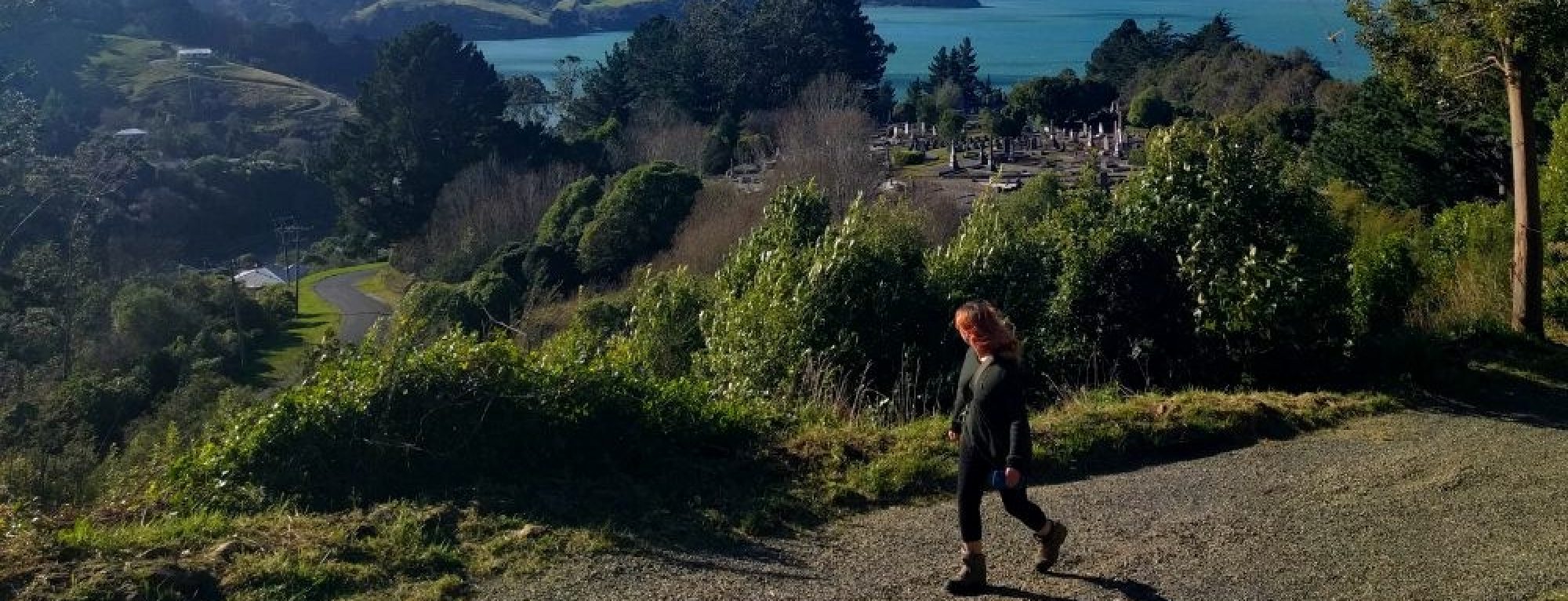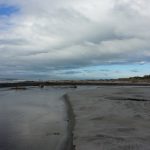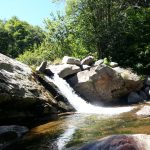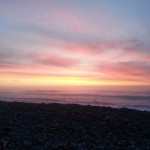Having arrived at Waipapa Point with Dad for our ANZAC Day adventure, we’d checked out the light house and learned the story of the tragic Tararua shipwreck. Now it was time for us to split up, with Dad to search for sea shells nearby, and me to seek out that “derelict gold dredge” I’d found marked on the topo map.
I began my hike down the beach and almost immediately got distracted by something I saw in the rocks.
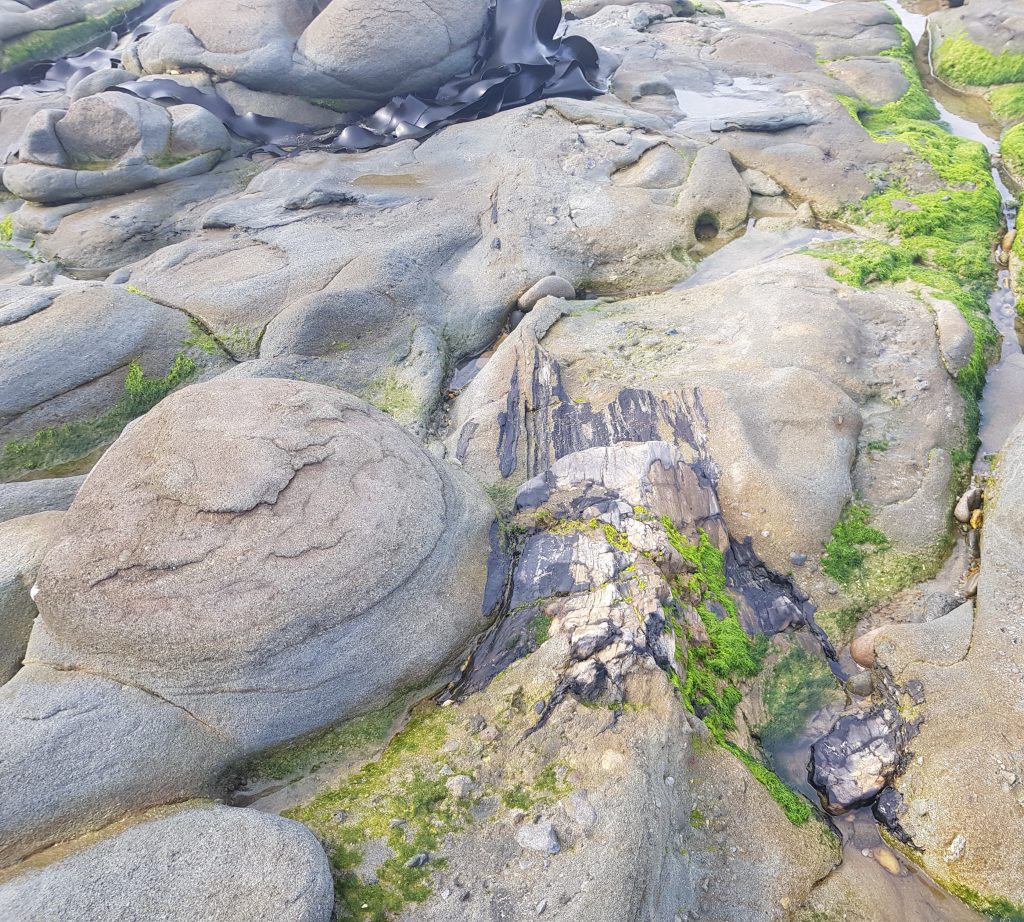
Could the petrified trees here be part of the 180 million year old Jurassic fossil forest that Curio Bay is famous for? If so then these trees would have been part of the forest that thrived back when this piece of New Zealand was part of the easternmost coast of Gondwanaland.
But no time to linger! I had a dredge to find!
As I continued eastward along the shore, it soon became apparent that no others had come this way recently. The smooth orange sand was broken only by the occasional sea lion track.

The sight of the outlet stream from Lake Brunton spurred me on, as I had already been walking for about 45 minutes and this was only the half way point! Seems the dredge was much further away than it had seemed on the map.
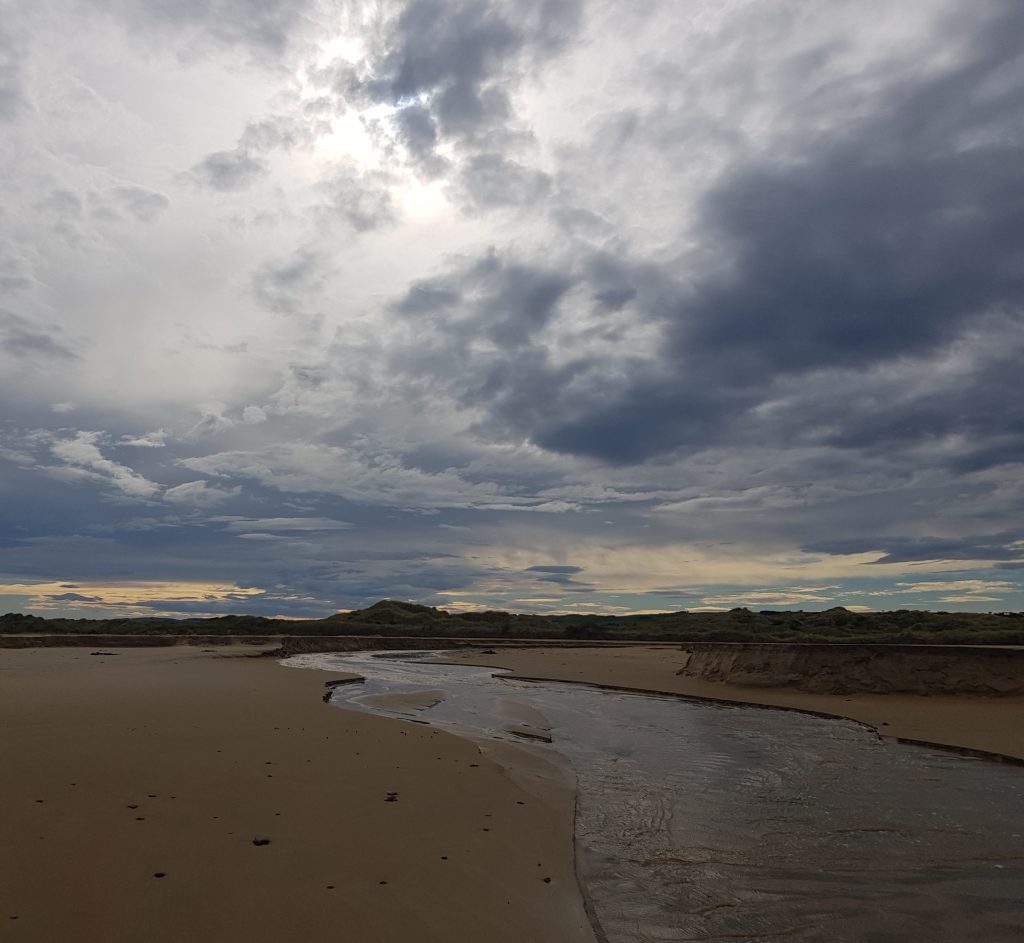
So I picked up the pace without any further dallying over sea shells or interesting rocks. Once or twice I considered giving up and returning but by now the sunk cost was too high. I just hoped Dad would understand that adventure takes time.
Finally the cliffs at the far end of the beach rose into view, and I decided to veer off into the sand dunes in order to avoid another odd thing that had been marked on the topo map: “Quicksand”.
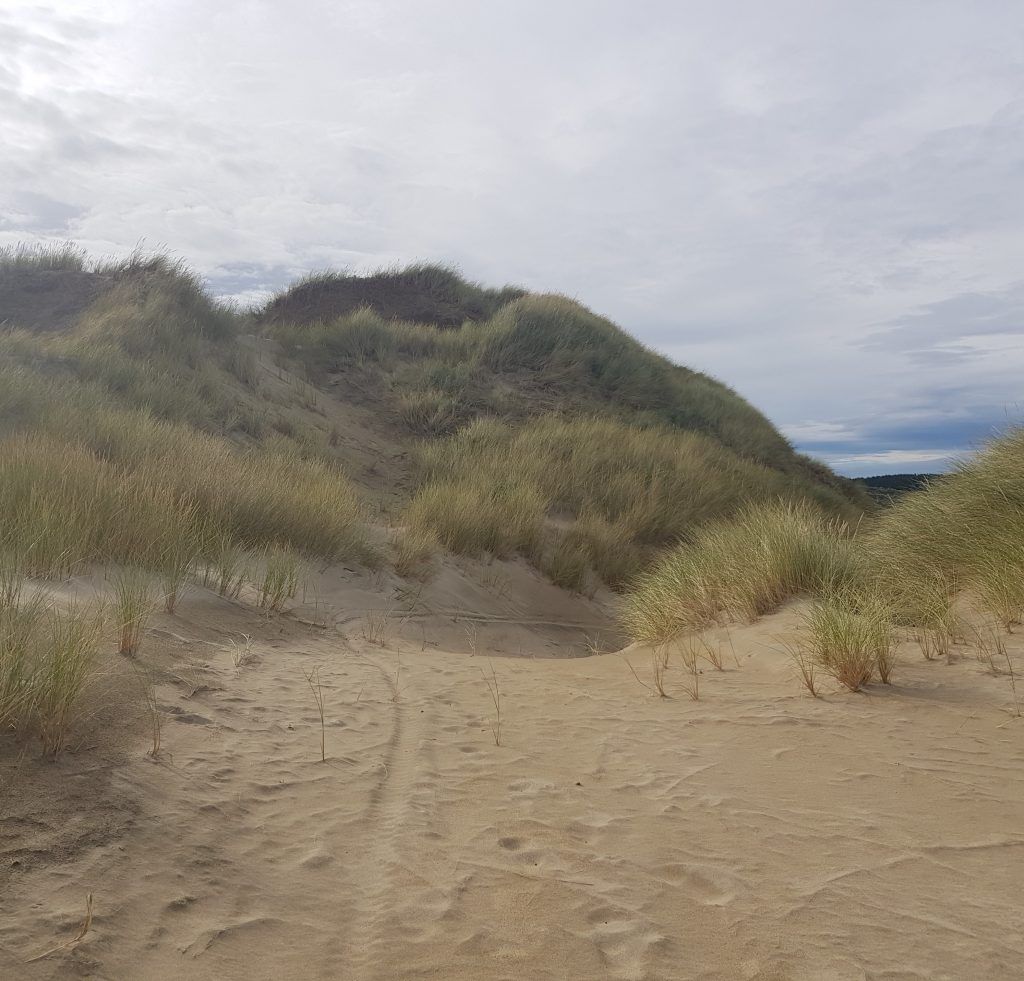
It was tough going. The scrub was thick and tangled and occasionally prickly, while the undulating terrain was a chore to navigate. What was worse, the dunes obscured all surrounding landmarks. I decided I must be on the right track when I reached the crest of one sandy ridge to find a flat swathe before me, only sparsely populated by plant life. Could this be the result of the dredging operation?
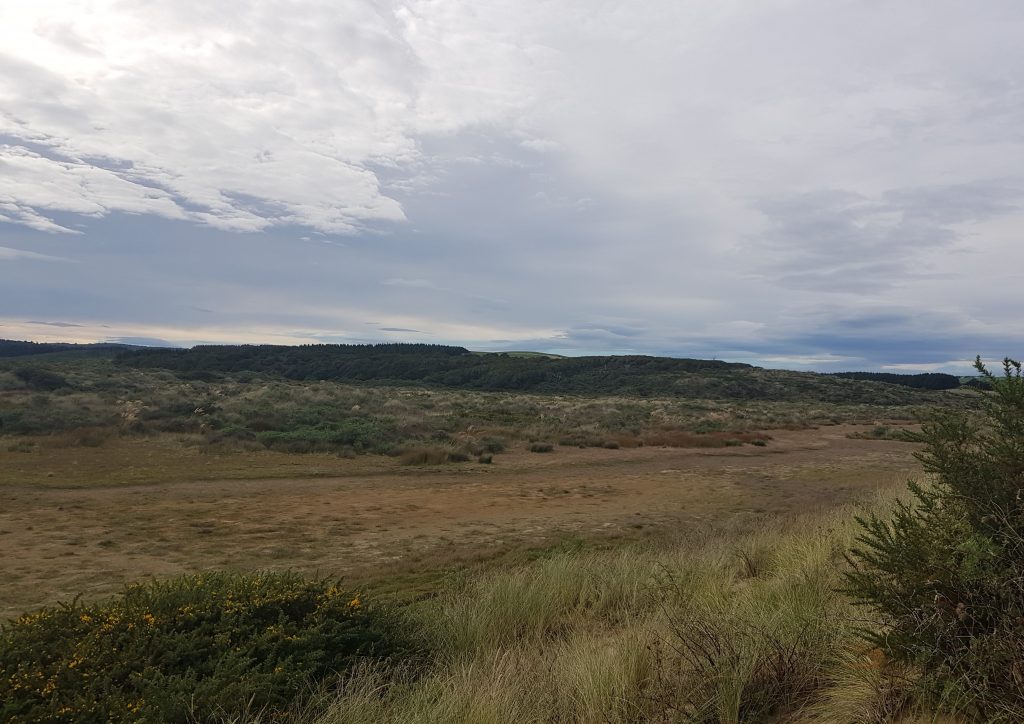
At least it was easier walking. But I was still lost, so I resorted to technology. I’d plugged the topo map coordinates into Google Maps on my phone before setting out, in the hope that it wouldn’t error out in the remote and signal-less wilds of Southland. Miraculously it was still working, and I slowly honed in on the alleged position of my target.
This took me out of the trough and back into the dreaded dunes. My phone was telling me I was almost on top of the dredge and yet I still could not see it. Disappointed, I decided that today technology had failed me.
Yet only a few paces more…and there it was!

I almost hugged the old rusty thing. This has been called “Southland’s best-preserved gold dredge”, though in all fairness I’m not aware of any competitors for that title.
In spite of the remoteness of this place and the difficulty of bringing in any serious machinery, sporadic attempts were made to extract the gold that many were certain abided in these sands. In 1888 the Waipapa Creek Gold-mining Company (later the Waipapa Dredging Company) managed to claim the sought-after eastern end of the beach (serviced as it was by a good stream) and managed to raise the capital to bring in a Welman suction dredge from England – one of the very first in what would eventually become a dredging boom.
No, this isn’t the Welman dredge. In fact, when this dredge was new the mouldering remains of that first were said to be seen rusting among the dunes. And when the first dredge was new, the half-buried remains of an “odd-looking machine” invented by an ingenious but impractical Invercargill gentleman still served as a monument to prospectors past.
I’m starting to think that if anyone tried digging here now, they’d find more mining machines than gold.

The dredging company, like those who came before, battled howling winds that flung sand everywhere and storms that flooded the stream and destroyed valuable equipment. Additionally, frequent breakdowns would hold up work for days or weeks at a time as repaired equipment needed to be shipped all the way to civilisation and back. Nevertheless the company lumbered on at a loss until 1893 when it finally shut down, having never paid a dividend to its eternally-hopeful shareholders.
And that was that…until another depression in the 1930s once again brought out speculators hopeful of unlocking the hidden riches beneath the sands. In 1934 the Waipapa Beach Gold Dredging Company was formed, and in 1935 the new dredge – diesel-powered rather than steam, bucket rather than suction – was launched not far from the remains of its predecessor.
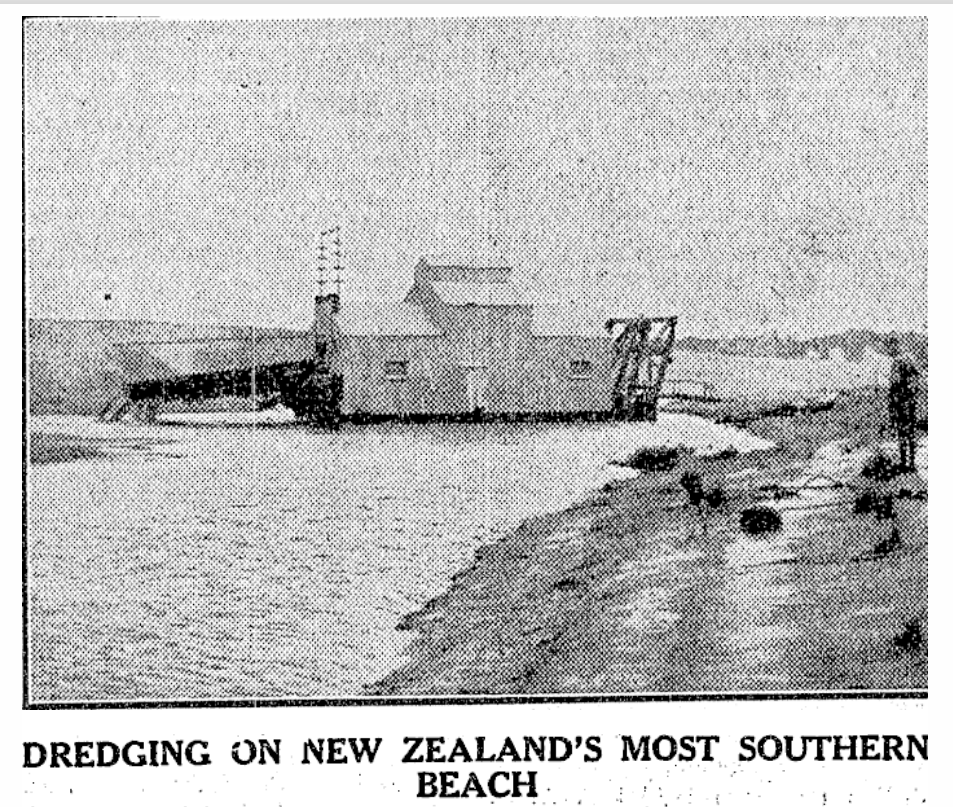
(You, like me, may have noticed that the dredge once sported a substantial wooden housing which no longer remains. Turns out those parts were recycled into farm buildings, some still in use as late as 1983.)
Despite battling with the same harsh conditions and regular breakdowns as the previous occupants of this claim, the company actually recorded a profit at its first annual meeting, and even paid a dividend to shareholders of 1 penny per share, which would be somewhat less than a dollar in today’s currency.
A second similar dividend was almost declared in time for the second annual meeting, but unfortunately the breakage of the crankshaft delayed it for several months.
Alas, by 1937 however it was deemed that the workable ground here had been exhausted. The company moved to secure their biggest asset – this dredge – by moving it to a location safe from the wild seas. They struggled to sell it, so searched for some other workable area they might move it to. Alas, no payable land could be found, so the directors reluctantly moved for liquidation.
One of the shareholders remarked rather bitterly:
It is a bad speculation to go in for gold mining—one might as well go in for horse racing. I think it would be wise to go into voluntary liquidation, and the sooner the company is wound up the better.
Furthermore, he asked:
If the dredge is left in its present position for the next three months what will its value be?
You don’t need a soothsayer to realise that the dredge did not ever move. As to its value, how can that now be calculated? To the hopeful shareholders she was a disappointment, perhaps all the more so due to the depression they had hoped to escape by means of the riches beneath these sands.

Now I realised that I too had spent too long among the dreams in these sands – Dad was probably wondering where the heck I had got to – so I hurried back along the beach, retracing my lone footsteps along the otherwise untouched shore.
We finally reunited – me apologising profusely for the approximately three hours I had spent lost in golden dreams on this shore, and him assuring me that he had been quite happily occupied with fossicking during that time.
Yet as we depart I can’t help but wonder – is there gold still in these inhospitable sand hills, or only the rusting remains of golden dreams?
References:
Early end for dredge by Lloyd Esler
GOLD DREDGING ON THE WAIPAPA BEACH. Otago Daily Times, Issue 8432, 4 March 1889
THE WAIPAPA DREDGINGCOMPANY. Otago Daily Times, Issue 9397, 9 April 1892
MISCELLANEOUS. Otago Witness, Issue 1948, 21 March 1889
WAIPAPA GOLD MINING COMPANY. Otago Daily Times, Issue 8445, 19 March 1889
Mining Jottings. Lake Wakatip Mail, Issue 1746, 14 February 1890
The Waipapa Dredge. Mataura Ensign, Volume 15, Issue 1344, 1 December 1893
Commerce, Mining, & Finance Evening Star, Issue 21947, 6 February 1935
COMMERCE AND FINANCE Otago Daily Times, Issue 22751, 11 December 1935
Commerce, Mining, & Finance Evening Star, Issue 22499, 18 November 1936
COMMERCE AND FINANCE Otago Daily Times, Issue 23053, 2 December 1936
Bonus from N.Z. Drug Co. Evening Star, Issue 22901, 8 March 1938
COMMERCE AND FINANCE Otago Daily Times, Issue 23452, 17 March 1938
The Jennings Families 1800-1985 West Cork to New Worlds By Gregg Jennings, John Fitzgerald
